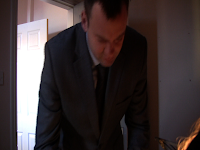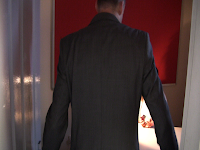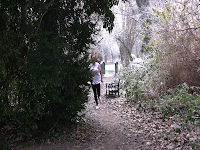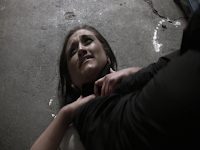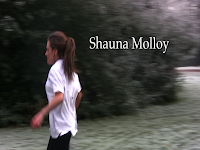Evaluate how our product used, developed or challenged the forms and conventions of real media products.
Predictions:
Audience feedback made negative or sad predictions about our main character.
Made us feel satisfied as it shows we have created the right emotions for a dark and mysterious thriller movie and made the audience fear for our character.
Title
- Red and white text comes on after the shot with Shauna’s hand scraping against tree, which is our title ‘Red Handed’.
- Fits well as we were trying to add the blood element into the title and this can be recognised.
- Suits the mysterious and scary feel of our genre.
Credits
- They are plain white and simple appear with a slide in effect when the main characters appear.
- We wanted to have simple credits from the moment we began, as our research showed us when adding in credits other thriller films made theirs simple and not over the top
Characters
- Thriller films are always about a young naive female and a strange but intelligent villain that puts in place obstacles and try’s to ruin the lives of the female and her family and friends and sometimes includes another male character that plays the hero.
- Characters used in thriller films are usually involved in some form of social problem, this is mainly the male characters.
- The villain is normaly angry and most commonly has a type of mental disorder which forces them to do these outrageous things and the hero normally has their own inner demons to fight during the course of the movie including having to prove something to themselves or others. We can see from close ups of Cristian that he is angry - the police character does not have time in 2 mins to establish his inner demons.
- Character of female often comes from good background with stable family and friend’s normal very popular and pretty. Also mainly tend to be white female playing this role - this is the case for us.
- Character of male hero consists mainly of a strong well-built handsome male who is intelligent.
- By casting Christian as the villain we in some ways are breaking our genres codes and conventions as we are casting a young teenage male when typically an older male would be cast - however making him young is more chilling in some ways as we wonder how someone of his age became so angry.
- As Shauna is a young niave character which is normally the type of person to play the victim. For example ‘The Hitch’ were Sophie Bush plays the stereotypical young vulnerable girl. youth makes them vulnerable and appealing.
- Our police hero does not appear much but is clearly a likeable character from his close ups and the warm lighting.
Mise-en-scène
- Typically set in working class locations.
- Normally with a miserable feel to it.
- Typically there is also a location such as the police station or interrogation rooms.
- Normally set in dark mysterious locations e.g. alleys, forests, mysterious houses etc.
- Thrillers tend to use unknown casts so people do not make predictions about the end of the film but also so they cannot connect with the character as quickly.
- We used considerable amount of props including knife, gloves, police badge and handcuffs. Mainly to create a dark and dangerous atmosphere.
- Showing these props in the police station showed to the audience that what they are watching is more credible.
- Main location used was the police interrogation room. We moved everything out of this room and only placed two chairs a table and a lamp into this room to make it unwelcoming.
- We wanted to create the feel that it was cold and chilling in this room, which made the main character Shauna still scared and worried. I still do not think we met the conventions of this location as normally they are in a room with not windows however although we did not choose shots that the audience could see the window we still did not meet this convention in our genre.
- The next location we used was a forest of this particular day it was very cold and icy which I think made our piece feel even more scary. I think we met the standards put in place by other films on the typical forest. Although we did not have our main character forcing her way through the leaves, branches, sticks etc. I still think this location worked well. As it seemed it was in the middle of nowhere, which is what we wanted.
- Final location is when Shauna being attacked, seems like a basement which is what we wanted to show.
- The costume for Christian is very stereotypical as he was dressed in complete black and wearing gloves this was to help hide his identity. This is often associated with villains and kidnappers.
- We cast Mr Simpson to be the police detective. He dressed in a typical suit and tie to show he is well respected and of high status.
- Finally Shauna dressed in a very common and distinctive vulnerable way as she wore a white T-Shirt and black leggings. White is nearly always used to show the characters vulnerability.
- We also made rips in her top and added fake blood to it to show she had been attacked and abused this was done to make her character more realistic. As the common conventions for thrillers is that the female character has scruffy and dirty cloths as they have faced horrible conditions.
- At the end of our 2-minute sequence the bloody knife dropped. We did this to keep the audience interested, as they now are not sure what happened and if Shauna really killed her kidnapper/stalker.
Camera work- We used many close ups in our film as we wanted the audience to feel emotions and sympathy towards our characters.
- These are typical in thrillers as it gives us time to concentrate and connect with the main character.
- Close ups enable us to make the audience feel the way we want them to feel which is sympathy towards our main character Shauna as close ups of Shauna’s bruised and upset face makes the audience feel for her and want to carry on watching so they know she is going to be ok.
- Also used over the shoulder shots when the interrogation scene is taking place. This is typically used in all different types of genres. It consists of a simple yet effective technique that shows a conversation.
- During the cross cutting shots we used a 360 shot as it was a difficult technique but it worked very well. We were trying to reveal to the audience that we were inside Shauna’s head and were watching her memories.
- We used a high angle shot of when Shauna runs over the bridge and is still running away from her kidnappers.
- We used a tracking shot of when Shauna was running to suggest that this film was going to go at a fast pace.
- There is not really codes and conventions as to what camera angles we could use in thriller films but I think we used a range of angles, which worked well.
Editing- We used quick cross cutting shots so that our film had a fast pace to it
- It is a typical technique in this type of film.
- We made the scenes of Shauna being attacked a bit darker so that it would give the impression it was a more dangerous and terrifying scene. Also it gave the shots more mystery as we were not to sure where they were.
Sound- The main type of music is non-diegetic sound. We chose a mysterious yet fast piece of music which was played throughout the first 2 minutes. To build up tension.
- However the music was lowered when speech was added especially in the interrogation scene, as it seemed there was no music during that scene.
- We used this type of music as it gave the piece as a whole a more chilling and frightening feel to it. It was definitely needed as it helps a lot with building up tension, which is the main premise of a thriller movie. It also gives the audience an indication that this film is going to be very emotional and exhilarating, as so far it has shown very dramatic events.
- The music we chose is very conventional music for this type of genre and I am glad we choose this as although it may not seem original it gives our piece believability.
- We have quite a bit of dialogue in our film. It is most defiantly essential as it helps the audience to feel more sympathy towards the main character but also does not entirely reveal the whole story line but lets the audience themselves think of different outcomes.
- In the dialogue scene the conversation is slow and quite. Which tells us that maybe Shauna is not entirely thinking about the questions Mr Simpson is asking but is thinking about what she done.
- We had to take out a lot of background noise gathered while filming the forest scene as it was right near a main road. This was a good choose as otherwise this scene would not have felt that dramatic and isolated which is what we wanting.

























